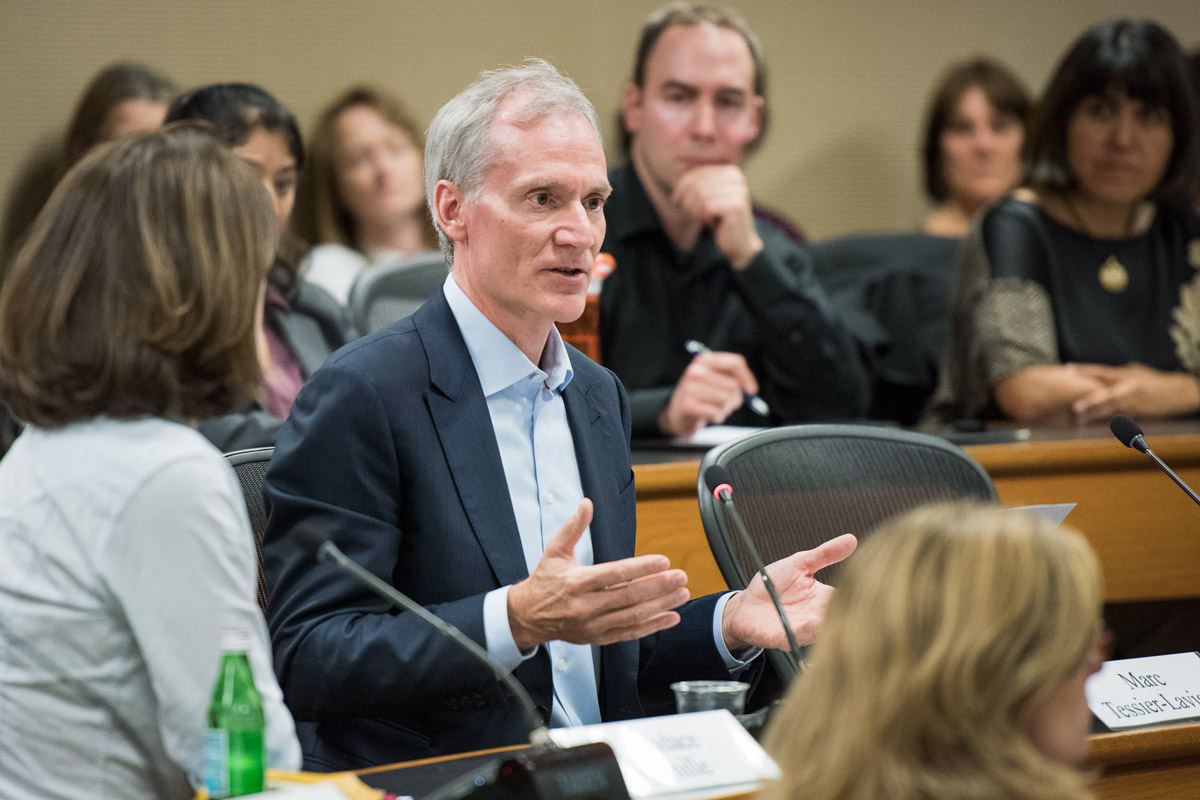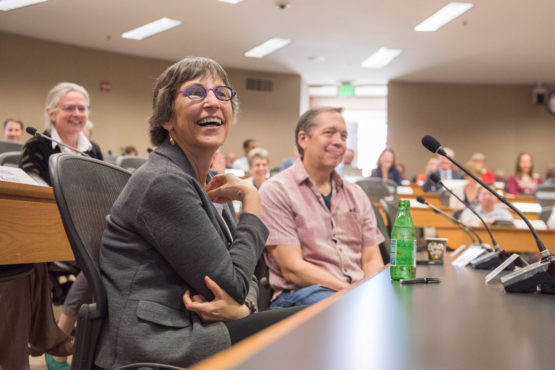In 2018, the following will celebrate their 50th birthday: Will Smith. The Big Mac. The Beatles’ hit song, “Hey Jude.” Hugh Jackman. “2001: A Space Odyssey.” And, last but certainly not least: the Stanford Faculty Senate.
The Faculty Senate makes academic policy at Stanford and debates a variety of other University-wide issues — in the past year alone, it has weighed in on academic diversity among faculty as well as students, campus sexual assault processes and your WAYS requirements. For the Senate’s 50th anniversary, The Daily put together a student-centric crash course to the Faculty Senate, what it does and why it matters.
What is the Faculty Senate?
The Faculty Senate is the legislative branch of the Academic Council, which is made up of all of Stanford’s tenure and tenure-line faculty. It exists to provide a Goldilocks-sized forum for discussion.
Before the founding of the Faculty Senate in 1968, faculty governance was conducted only by the full Academic Council and a nine-member Executive Committee. The Academic Council, which met only once a quarter, was too large for effective debate. (Currently, the Academic Council consists of upwards of 1000 members.) On the other hand, the University decided that the Executive Committee was too small to capture the diverse range of voices within the faculty. The Senate was designed to split the difference.
Today, the Faculty Senate includes 55 elected members, 15 ex officio members, who have the right to speak but not to vote, and three ASSU representatives, who share the same rights as the ex officio members. Senators are elected from 12 units based on school and discipline for staggered two-year terms. Council members (other Stanford faculty) vote to elect Senators within their unit. However, once Senators are elected, they are free agents and don’t represent their particular unit.
Instead, the Faculty Senate as a whole serves two main functions: First, it makes and approves academic policy. This involves creating new degree-granting programs, such as honors and joint degree programs like CS + X, as well as wider policy on research and undergraduate financial aid. It also includes University-wide curriculum requirements — love or hate the WAYS requirements, the Faculty Senate was behind their approval in 2012 and continues to oversee program outcomes and future changes.
In June, a report to the Senate showed that the switch to WAYS from IHUM — the previous breadth requirement — corresponded to a 50 percent drop in the number of freshmen taking humanities courses. In the meantime, students have unknowingly built their academic experiences around the policies that the Faculty Senate approves and assesses.
Second, the Senate serves as a forum for candid dialogue between faculty and various other University groups, including students and the administration. Recent discussion topics include faculty diversity, Stanford’s offshore investments, a visit by Jihad Watch founder Robert Spencer, the University-wide long-range planning process, the House’s tax plan and more.
When Spencer spoke at Stanford in November, Senator and Graduate School of Business professor Jeremy Bulow questioned whether Stanford should pay thousands of dollars for event security to facilitate the event, suggesting instead that speakers sign a waiver of liability. The discussion came amid campus-wide debate about whether the event should be permitted in the spirit of supporting free speech in universities or censured for giving Islamophobic hate speech a platform.
In response to Bulow’s proposal, Provost Persis Drell made the University’s stance clear.
“We need to defend free speech,” said Drell. “If it costs, it will cost.”
Anti-war movement
Difficult as it may be to think of a group of people more stereotypically staid than the professoriate, the Faculty Senate has been involved in its share of historical drama from its inception. Founded in 1968 at the height of anti-war political unrest, its early history is closely tied to the “student war at Stanford,” which roiled Stanford for most of the decade.
A landmark decision at the time was the removal of credit for ROTC courses, effectively forcing ROTC off campus. The academic policy had real consequences for students and the political debates on campus — the gravity of which was reflected in the Senate’s deliberation on the matter. Between 1969 and 1970, the Faculty Senate changed its policy on ROTC courses a total of three times, first voting against the ROTC, reversing that decision and finally revoking all academic credit for freshman ROTC courses.
Student activists protested ROTC at mass sit-ins and demonstrations that occasionally escalated into violence and even arson in the late 1960s, but faculty members who opposed ROTC as well were more phlegmatic in their reasoning.
“Basically the curriculum was awful,” says Barton Bernstein, a history professor who was a leader in the 1969 movement against ROTC. “It was on the level of mediocre coursework in high school. The readings were sophomoric. The ROTC faculty were not PhDs. I think it was the case that some [opponents to ROTC] had deeper political purposes, but everybody could agree that it was an intellectual embarrassment.”
Over 40 years later, in another controversial decision, the Senate voted to invite ROTC to return to Stanford. In a jam-packed Faculty Senate session, the ASSU spoke on behalf of the student body in urging Faculty Senate members to vote “no” on the ROTC’s return.
“ROTC does not align with the vision of this University,” said the ASSU president at the time, Michael Cruz ’12. “Currently, Stanford is one of the safest communities for transgender students in the world. I want to make sure all Stanford students feel safe enough to call this place home as well.”
Ultimately, the Faculty Senate voted to invite ROTC back to campus in a resolution that included a condemnation of the military’s discrimination against transgender people. William Perry, Michael and Barbara Berberian Professor (emeritus) at the Freeman Spogli Institute and Engineering, said he hoped Stanford-educated members of the armed forces would make military policy more progressive.
“Stanford has the opportunity to help create military leaders that will later make these enlightened decisions,” said Perry, speaking about the repeal of Don’t Ask, Don’t Tell in support of ROTC’s return.
Whatever the outcome, the decision of whether to grant academic credit, and how, is a question of how Stanford conducts its mission to educate and what it thinks students should be learning — plus all the political implications that come with it.

The Faculty Senate now
The student government has often treated the Faculty Senate as a platform to be heard by the instructors and researchers who define the academic experience at Stanford.
Successive generations of ASSU executives have been pushing the Faculty Senate to support a “Diversity in the Field” requirement — a major-specific diversity requirement beyond the course needed to complete Engaging Diversity under the WAYS system — since the 2015-16 academic year. At a Senate meeting in October, Justice Tention-Palmer ’18 and Vicki Niu ’18, student body President and Vice President, presented a report focused on the need for increased diversity in teaching, courses and mentorship.
“Fifty-one percent of white students felt that Stanford faculty cared about them, compared to only 35 percent of Black or African American students,” said Niu. “And we think that gap is unacceptable. Similarly, only 21 percent of non-first-generation students felt very often overwhelmed by their work, compared to a much higher 38 percent of first-gen undergraduates. And in thinking about ways that we can lessen that gap, a lot of it is in the kind of classroom environments that we create.”
In the wake of a 2016 Undergraduate Senate bill to rename University property named after Junipero Serra, it also took the Faculty Senate to approve the University committee that would deliberate the renaming process one month after the undergraduate resolution.
Why should we care?
Just because the fact that the Faculty Senate has at least 11 committees at any given time does not mean that it is immune to Stanford’s culture of wacky traditions. Every year, the Senate pays tribute to the outgoing chair in skit form. The final meeting of the 48th Faculty Senate produced the following gem from Dean of the Humanities & Sciences Richard Saller:
“Because we have no voting items on the agenda today, we do not have to pretend to know Robert’s Rules of Order,” said Saller. “I wish to remind you, though, that once more our meeting format is a bit different; presenters will give short presentations followed by substantial, and usually pointless, discussion. This is made possible by Senators having pretended to have read the material that we sent to them ahead of time.”
Faculty: They’re just like you!
In all seriousness, the concerns of the Faculty Senate are not far from the concerns many students have. Have a strong opinion on faculty diversity or student activist group Who’s Teaching Us? The Faculty Senate has looked at the numbers and discussed the policy on inclusive hiring. Think undocumented students should get more support? An undergraduate senator brought that question to a Faculty Senate meeting and got a response on Stanford’s financial aid policy for undocumented applicants from then-Provost John Etchemendy.
Whether students know it or not, the Faculty Senate makes and deliberates University-wide policies that affect students some way or the other — and the good news is, most meetings are open to all. (As are the Stanford Daily recaps that go live every Friday morning.)
Contact Erin Woo at erinkwoo ‘at’ stanford.edu.
